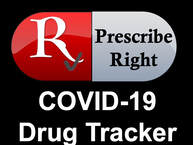|
Remdesivir
Gilead announced interim results from 397 patients enrolled in a 6,000 patient, Phase III, SIMPLE trial (NCT04292899). There was no difference in efficacy, measured on a seven-point scale that runs from death to not hospitalized, between a 5-day course of remdesivir and a 10-day course in hospitalized patients with severe COVID-19. The data suggested that earlier treatment was more efficacious than later treatment. NIAID announced preliminary data from a 29-day, 1,063 patient, Phase III, Adaptive COVID-19 Treatment Trial (ACTT) trial (NCT04280705), where patients treated with remdesivir for up to ten days had a median time of recovery (hospital discharge or returning to normal activity level) of 11 days compared to 15 days with placebo in patients with severe COVID-19. There was a non-significant difference in the mortality rate of 8% with remdesivir compared to 11.6% with placebo. The ACTT trial was closed to enrollment on April 19. In a 28-day, 237 patient, Phase III, Chinese trial, treatment with remdesivir for ten days was not associated with a clinical benefit compared to placebo (non-significant 20 days vs 23 days) in hospitalized patients with severe COVID-19 infection (NCT04257656). Due to a decrease in patients with COVID-19 infections in China, enrollment was suspended after 237 patients entered the study instead of the target of 450 patients, which reduced the statistical power from 80% to 58%. The researchers noted they “could not exclude clinically meaningful differences and saw numerical reductions in some clinical parameters". Confounders in this study included 54% of the patients in the remdesivir group receiving the drug more than 10-days after developing symptoms compared to 40% of placebo patients. Almost 30% of remdesivir patients received interferon and/or lopinavir–ritonavir. While use of lopinavir–ritonavir was similar in both groups, 38% of patients received interferon. The placebo group was 65% male compared to 56% in the remdesivir group. These differences could have been due to the final population not reaching the target total. The New York Times reported the FDA will likely issue an emergency authorization for remdesivir. Sarilumab Sanofi and Regeneron announced interim results from a Phase II/III trial, where treatment with sarilumab did not improve clinical outcomes in severe and critical COVID-19 patients. Though not statistically significant, patients requiring oxygen supplementation, but not ventilation (severe infections), had a trend toward a worse outcome with sarilumab, but those requiring ventilation had a trend toward a benefit. Due to the trend of worsening in patients requiring oxygen supplementation, but not ventilation (severe infections), the researchers are discontinuing enrollment of severe COVID-19 patients, but since there was a trend toward a better outcome in patients requiring ventilation (critical infection), patients with critical COVID-19 infections will continue to be enrolled. COVID-19 Guidelines The Infectious Diseases Society of America (IDSA) has published guidelines for preventing infection in health care professionals (HCP) caring for suspected or known COVID-19 patients. The guidelines provide eight recommendations on the use of personal protective equipment (PPE) in conventional, contingency and crisis capacity settings. COVID-19 Vaccine BioNTech is developing an mRNA vaccine for the COVID-19 virus. While mRNA vaccines can be designed, manufactured and tested faster than typical vaccines, they have not been proven to be efficacious or safe. BioNTech expects to begin clinical testing by the end of April 2020. Forsum Pharma will market BNT162 in China. Pfizer will co-develop and market BNT162 outside of China. BioNTech and Pfizer initiated a 200 patient, Phase I/II trial in Germany in April. The trial is expected to begin enrolling patients in the U.S. in May. Four vaccine candidates are being tested. Three require two doses, while the fourth contains self-amplifying mRNA and requires a single dose. Pfizer expects data from the first trial to be available in May or June with a successful vaccine candidate moving to larger trials and possibly emergency use or accelerated approval in the 4Q20. The journal Nature provided a graphical description of the different types of methods to create a vaccine that are currently being used to work on a vaccine for COVID-19. Comments are closed.
|
Stay informed, subscribe to the Prescribe Right Pharmaceutical Pipeline Tracker
Archives
January 2023
Categories |
Services |
Company |
Support |
© COPYRIGHT 2015. ALL RIGHTS RESERVED.
|


 RSS Feed
RSS Feed